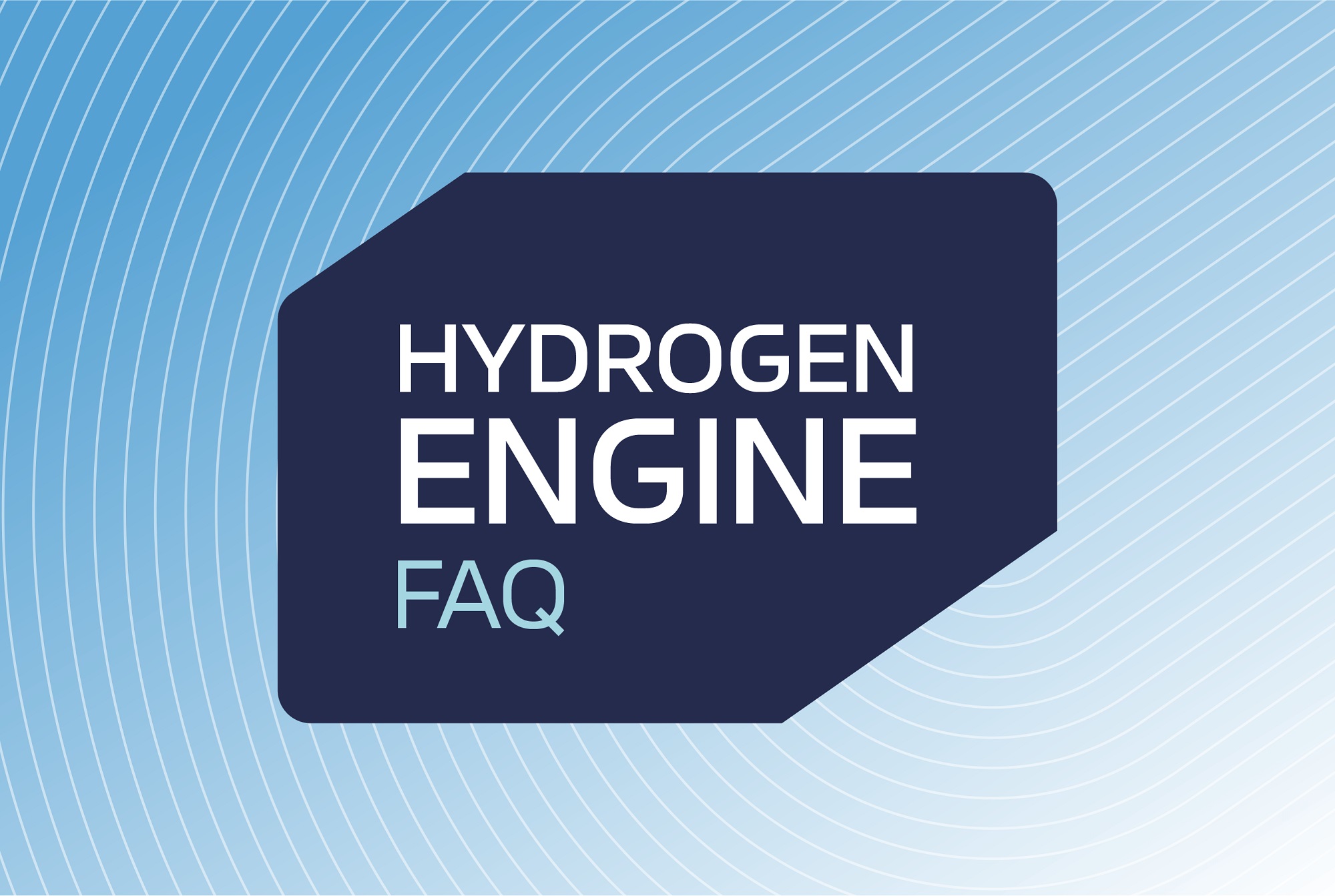Frequently asked questions about hydrogen engines
Hydrogen engines are getting more attention as the commercial transportation sector is defining its path to lowering and eliminating carbon emissions. With this article, you can now find answers to frequently asked questions around hydrogen engines.
By Jim Nebergall, General Manager of the Hydrogen Engine Business

Can an engine run on hydrogen?
Absolutely! How today’s hydrogen engines work is very similar to natural gas and gasoline engines with respect to its working principle and architecture. They just run on hydrogen - a zero carbon fuel. And, they are coupled with high pressure gas cylinders, which are a safe and practical way to store hydrogen onboard.
Are hydrogen engines viable?
From a technical standpoint, hydrogen engines are perfectly viable. They work and they’re reliable. They only differ in small ways from traditional internal combustion engines—which are among the most reliable mechanical devices ever created.
The more difficult question may be—are vehicles with a hydrogen engine viable? The answer; it depends.
In some parts of California (U.S.), Japan, and Europe, where there are a few dozen publicly accessible fueling stations pumping hydrogen, personal vehicles running on hydrogen are an option. However, in most other places refueling would be an issue. This makes hydrogen engines only moderately viable for personal cars and SUVs.
Commercial vehicles, on the other hand, are a much better fit for hydrogen engines. This is particularly true of commercial vehicles that are part of a fleet with a central “home base” where a dedicated hydrogen fueling point may be created. Vehicles such as refuse trucks, delivery trucks, emergency services vehicles and more are all good fits. This is also true of regional and long-haul trucks, provided that a few hydrogen fueling stations are built along select shipping routes. Interested in learning more? Dive into the examples of hydrogen engines in mobility and transportation.
Why aren’t more commercial vehicles powered by hydrogen engines?
Many commercial fleet operators have goals to reduce their carbon footprint as part of their broader sustainability strategy. Hydrogen engines can significantly contribute towards accomplishing these sustainability goals, yet the widespread adoption of hydrogen engines is not there.
The lack of serial production of hydrogen engines for commercial transportation vehicles is one key limitation. Yet, this is about to change with the recent announcement that Werner Enterprises will begin validation and integration of Cummins’ 15-liter hydrogen internal combustion engines in its vehicles.
The capital cost of new vehicles with hydrogen engines will be different than diesel powered ones; meanwhile the design commonalities between hydrogen and diesel engines will result in hydrogen engines becoming affordable for a near-zero emission power technology.
Hydrogen infrastructure readiness is another limiting factor for some commercial vehicle applications, but not all. As mentioned above, some commercial vehicle applications are viable applications for hydrogen engines. As more vehicles with hydrogen engines get onto our roads, this also benefits the hydrogen infrastructure buildup.
Finally, operating a vehicle on hydrogen is not necessarily going to cost less than operating the same vehicle on gasoline or diesel—at least in the absence of government incentives. This equation, however, may change in the next years. The primary driver for this change is a set of new regulations designed to curb CO2 emissions by heavy and medium-duty trucks in Europe, China and multiple U.S. states. For vehicle manufacturers and fleet operators impacted by those rules, switching to hydrogen engines may well turn out to be the most economical way to achieve compliance. If this is the case, expect to see hydrogen trucks and other vehicles appear on the roads this decade.

How long do hydrogen engines last?
The same as a diesel engine. Hydrogen engines operate on the same cycle as diesel and natural gas engines and have the same engine components below the cylinder head including the engine block, crank, connecting rods, and so on.
The use of hydrogen as a fuel could introduce risks around hydrogen embrittlement and erosion within the engine. Cummins Inc. is already testing hydrogen engines to mitigate any of these risks; and we will share our findings as our tests progress.
At the tailpipe, or tank-to-wheel level, hydrogen engines don’t emit CO2 originated from the hydrogen fuel. This is because there is no carbon atom in hydrogen. Meanwhile, hydrogen engines emit trace amounts of CO2 due to the lubricant involved in engine operations, and the fact that the engine uses ambient air for combustion containing CO2.
At the well-to-wheel level, hydrogen engines’ carbon footprint depends on where the hydrogen is coming from. If five pounds of CO2 is released into the atmosphere every time one pound of hydrogen is produced, then trucking on hydrogen is hardly an environmentally friendly mode of transportation. This is unfortunately the case with most of the hydrogen produced industrially today. Most of it is obtained by processing methane, a fossil fuel. If, on the other hand, green hydrogen is produced by electrolysis using electricity generated by renewable resources such as solar arrays or wind turbines, then hydrogen engines with only trace amounts of carbon emission is possible.
Cummins is already pioneering the green hydrogen generation through investments into electrolyzer production in Spain. Cummins is also partnering with Sinopec to research, develop, and manufacture electrolyzers in China.
Hydrogen engines do, however, release some NOx, just like diesel and natural gas engines. Hydrogen engines require an exhaust treatment system to remove the excess NOx. As a result, hydrogen engines will reduce NOx to extremely low levels – even lower than the requirements by EPA regulations for diesel engines in trucks today.
What is the range and tank fill time of a hydrogen engine?
This depends on the tank size and type. Hydrogen is stored in compressed gas form on vehicles, contained within pressure vessels with nominal working pressure of 350 bar or 700 bar.
Let’s take an onboard hydrogen storage system that consists of 700 bar fuel tanks with a total usable hydrogen capacity of 80 kilograms. This system would enable a range of 500 miles for the vehicle before the need to refuel. It will take about half an hour to refuel this vehicle.
Are hydrogen engines used in vehicles safe?
Hydrogen tanks are much more sturdy than traditional liquid fuel tanks—or even than propane tanks. They are also subject to strict safety standards. These standards cover a variety of requirements such as post-crash integrity, resistance to penetration, resistance to high temperatures and a maximum-pressure safety factor of three. This safety factor means that a storage vessel planned to be used at 700 bar maximum operational pressure, is actually designed for more than 2,100 bar pressure level.
Cummins has recently formed a joint venture with ETC named NPROXX, a leader in hydrogen storage and transportation, for hydrogen storage tanks. This joint venture is a leader in the European rail market and will provide hydrogen and compressed natural gas storage products for on-highway and off-highway applications.

Where can I get hydrogen to fuel my vehicles?
If your business is based in certain parts of California (U.S.), Europe, or Japan, then you can refuel on hydrogen at any of the few dozen gas stations equipped to dispense hydrogen.
Otherwise, your first option may be to work with a specialized supplier of hydrogen that can setup a basic fueling point on the premises of your business then supply you with green hydrogen. While this type of service may not be available everywhere just yet, commercial green hydrogen is a rapidly growing industry which more startups and large companies join every day.
If your area is not served by green hydrogen vendors, you may also have the option to self-produce green hydrogen. For this, electrolysis and solar generation or standalone electrolysis solutions can suit the needs of a large range of fleet operators.
Author Profiles

Jim Nebergall, General Manager of the Hydrogen Engine Business
Jim Nebergall is General Manager of the Hydrogen Engine Business at Cummins Inc. and leads the company’s global efforts in commercializing hydrogen-fueled internal combustion engines. Hydrogen internal combustion engines are an important technology in the company’s accelerated path to decarbonization. Jim joined Cummins in 2002 and has held numerous leadership roles across the company. Most recently, Jim was the Director of Product Strategy and Management for the North American on-highway engine business. Jim is passionate about innovation and has dedicated his Cummins career to advancing technology that improves the environment. He pushed the boundaries of customer-focused innovation to position Cummins as the leading powertrain supplier of choice, managing a portfolio ranging from advanced diesel and natural gas to hybrid powertrains. Jim graduated from Purdue University with a bachelor’s degree in electrical and computer engineering. In 2007, he completed his Master of Business Administration degree from Indiana University.
Related Tags